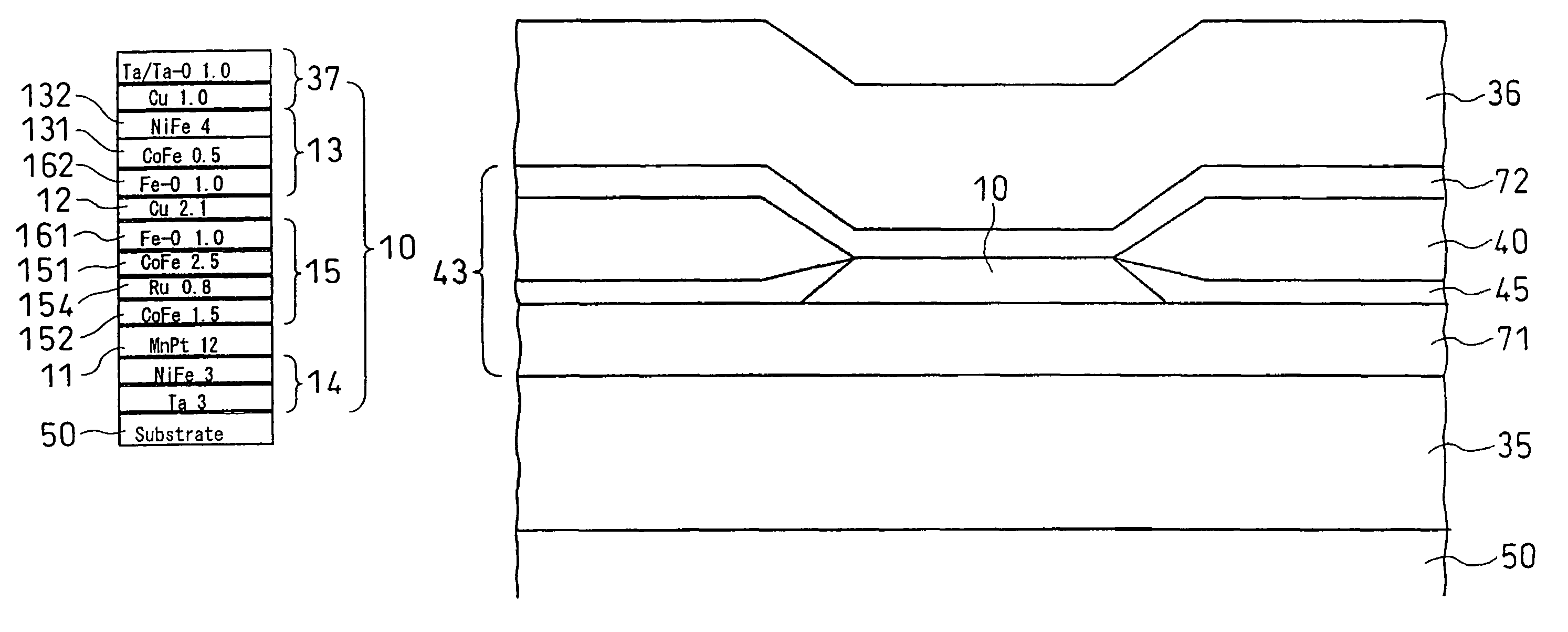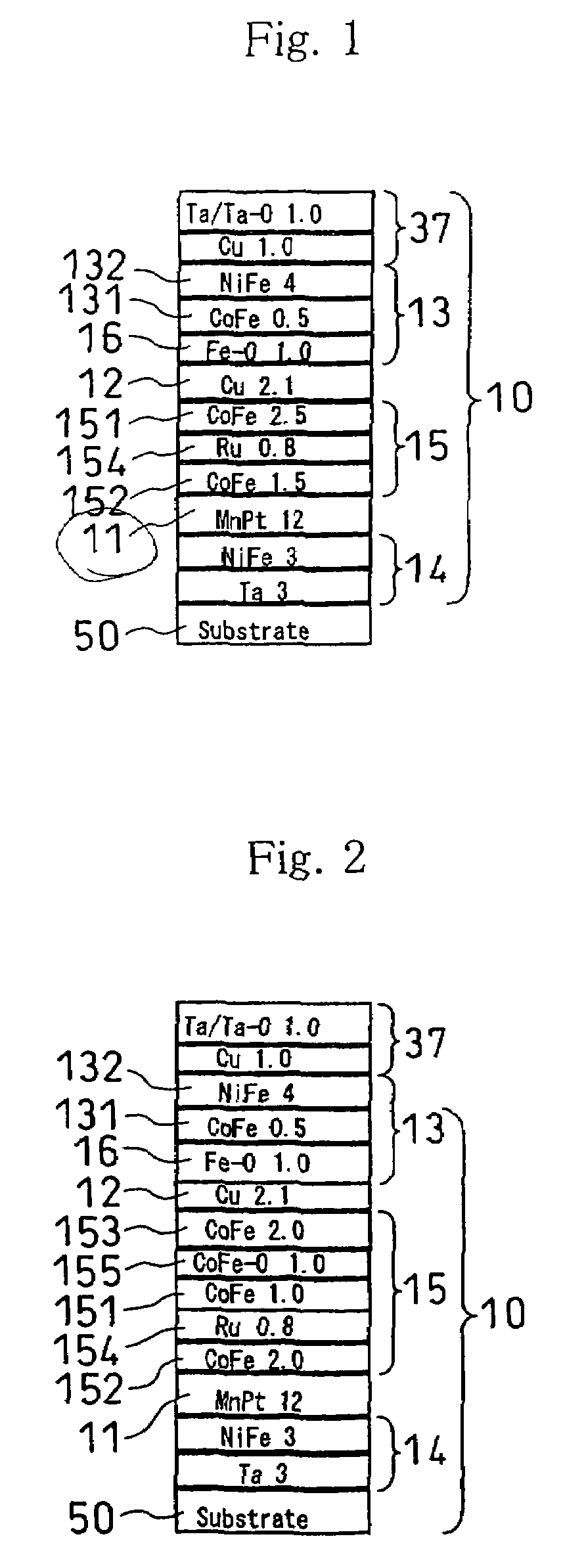Magnetoresistive element with oxide magnetic layers and metal magnetic films deposited thereon
a magnetoresistive element and oxide technology, applied in the field of magnetic recording/recreation, can solve the problems of amorphous or microcrystal structure or heterogeneous crystal structure, difficult to laminate thin metal films such as ferromagnetic metal layers and high-polarized oxides for fabricating magnetoresistive elements, and deterioration in properties, so as to achieve sufficient reproducibility output, prevent noise from occurring, and narrow width
- Summary
- Abstract
- Description
- Claims
- Application Information
AI Technical Summary
Benefits of technology
Problems solved by technology
Method used
Image
Examples
embodiment 1
[0045]A thin film making up a giant magnetoresistive element multi-layered film according to the present invention is fabricated by radio-frequency magnetron sputtering equipment as described below. In the atmosphere, in which 1-6 mm Torr of argon is present, the materials described below are sequentially laminated on a ceramic substrate with a thickness of 1 mm to form the thin film. Tantalum, nickel-20 at % iron alloy, cupper, cobalt, MnPt, ruthenium, and Fe3O4 (magnetite) are used for sputtering targets. One square cm of Fe and Ni chips are appropriately disposed on a Co target for adjusting the composition. Similarly, one square cm of, for example, Fe chips are disposed on the magnetite target for adjusting the composition.
[0046]Hereafter, the composition with the Fe—O layer formed is expressed by the total amount of magnetite (Fe3O4) plus Fe, for example, the expression Fe10 at % in the Fe—O layer means Fe3O4 90 at %-Fe10 at %.
[0047]To sequentially form individual layers of the...
embodiment 2
[0054]Similarly, FIG. 2 shows another example composition of the magnetoresistive multi-layered film to be used for the magnetoresistive element according to the prevent invention. The notation in the figure is the same as that of FIG. 1. The magnetoresistive multi-layered film 10 is formed by continuously laminating the underlayer film 14, antiferromagnetic film 11, ferromagnetic pinned layer 15, non-magnetic intermediate layer 12, the soft magnetic free layer 13, and the protective film 37 on the substrate 50. With respect to the multi-layered composition, electric resistance varies with the angle defined between the magnetization orientation of the ferromagnetic pinned layer 15 and that of the soft magnetic free layer 13 by means of giant magnetoresistance or tunnel magnetoresistance. Since the compositions and effects of the underlayer film 14 and the like, the soft magnetic free layer 13, and the like are the same as those shown in FIG. 1, their descriptions are omitted. If the...
embodiment 3
[0058]FIG. 3 is the view showing a further another example of the magnetoresistive multi-layered film to be used for the magnetoresistive element of the present invention. The notation in the figure is the same as that shown in FIG. 1. The magnetoresistive multi-layered film 10 is formed by continuously laminating the underlayer film 14, the antiferromagnetic film 11, ferromagnetic pinned layer 15, non-magnetic intermediate layer 12, the soft magnetic free layer 13, and the protective film 37 on the substrate 50.
[0059]With respect to the multi-layered composition, electric resistance varies with the angle defined between the magnetization orientation of the ferromagnetic pinned layer 15 and that of the soft magnetic free layer 13 by means of giant magnetoresistance or tunnel magnetoresistance. Since the compositions and effects of the underlayer film 14 and the like are the same as those shown in FIG. 1, their descriptions are omitted. If the composition of the underlayer film 14 or...
PUM
| Property | Measurement | Unit |
|---|---|---|
| thickness | aaaaa | aaaaa |
| thickness | aaaaa | aaaaa |
| temperature | aaaaa | aaaaa |
Abstract
Description
Claims
Application Information
 Login to View More
Login to View More - R&D
- Intellectual Property
- Life Sciences
- Materials
- Tech Scout
- Unparalleled Data Quality
- Higher Quality Content
- 60% Fewer Hallucinations
Browse by: Latest US Patents, China's latest patents, Technical Efficacy Thesaurus, Application Domain, Technology Topic, Popular Technical Reports.
© 2025 PatSnap. All rights reserved.Legal|Privacy policy|Modern Slavery Act Transparency Statement|Sitemap|About US| Contact US: help@patsnap.com



